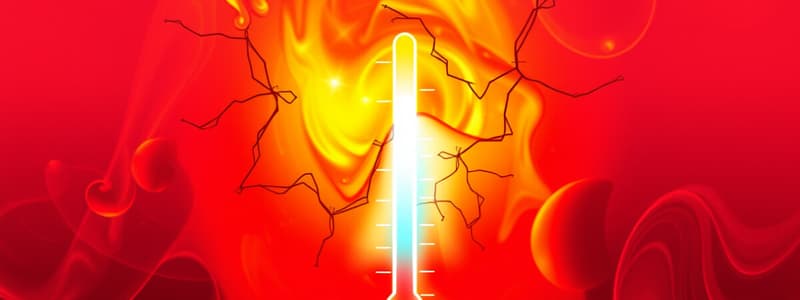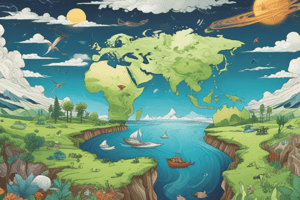Podcast
Questions and Answers
What is temperature?
What is temperature?
- The weight of a substance.
- A measure of the average kinetic energy of molecules. (correct)
- A measure of heat energy in grams.
- The speed of sound in a substance.
What is heat energy referred to as?
What is heat energy referred to as?
- Kinetic energy of molecules (correct)
- Temperature
- Thermal energy (correct)
- Potential energy
What do dryas flowers do?
What do dryas flowers do?
They use the parabolic shape of their flowers to concentrate solar energy on their reproductive structures.
Why is temperature important to organisms?
Why is temperature important to organisms?
How do macroclimate and microclimate interact?
How do macroclimate and microclimate interact?
What distinguishes macroclimate from microclimate?
What distinguishes macroclimate from microclimate?
What factors influence microclimate?
What factors influence microclimate?
Why are temperatures usually cooler at higher elevations?
Why are temperatures usually cooler at higher elevations?
What role does aspect play in microclimates?
What role does aspect play in microclimates?
How do vegetation and ground color affect microclimates?
How do vegetation and ground color affect microclimates?
What is the effect of boulders and animal burrows on microclimate?
What is the effect of boulders and animal burrows on microclimate?
What are the main reasons for thermal stability in aquatic environments?
What are the main reasons for thermal stability in aquatic environments?
How much energy is required to heat 1 cm³ of water by 1°C?
How much energy is required to heat 1 cm³ of water by 1°C?
Flashcards are hidden until you start studying
Study Notes
Temperature and Heat
- Temperature: Measures average kinetic energy of molecules in a substance.
- Heat: Describes the kinetic energy within a mass of a substance.
Dryas Flowers
- Dryas flowers have a parabolic shape to concentrate solar energy on reproductive structures.
- Insects warm themselves on these flowers, aiding pollination.
Importance of Temperature
- Temperature influences chemical reaction rates, crucial for processes like photosynthesis and respiration.
- Organisms are adapted to a specific temperature range for optimal functioning.
Climate Interactions
- Macroclimate: Long-term weather conditions in a region.
- Microclimate: Short-term climatic variation occurring over small scales influenced by local landscape features.
Influences on Microclimate
- Factors include altitude, aspect (direction faced), vegetation, ground color, and presence of boulders.
- Water and soil characteristics limit temperature fluctuations in aquatic environments and animal burrows.
Altitude and Temperature
- Cooler temperatures at higher elevations due to decreased atmospheric pressure and reduced air density.
- Less atmosphere at higher elevations means decreased heat retention.
Aspect and Microclimates
- Topography creates shaded and sunlit areas; north-facing slopes in the Northern Hemisphere are cooler and moister.
- Southern Hemisphere follows a similar pattern with southern aspects receiving less sunlight.
Vegetation and Microclimates
- Plants provide shade, creating cooler microclimates; vegetation types can significantly affect local thermal environments.
Ground Color Effects
- Different ground colors, such as white or black sand beaches, create varying microclimatic conditions.
Boulder and Burrow Impacts
- E.B. Edney’s research showed stones can create significant temperature differences; Ligia oceanica thrived under stones at higher temperatures compared to open air.
- Animal burrows typically feature moderated temperatures compared to surface conditions.
Aquatic Temperature Stability
- Water's high specific heat contributes to thermal stability, absorbing much heat without significant temperature changes.
- It requires significantly more energy to heat water compared to an equal volume of air, leading to consistent aquatic temperatures.
Studying That Suits You
Use AI to generate personalized quizzes and flashcards to suit your learning preferences.




